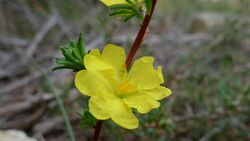Biology:Hibbertia fasciculata
| Hibbertia fasciculata | |
|---|---|

| |
| Scientific classification | |
| Kingdom: | Plantae |
| Clade: | Tracheophytes |
| Clade: | Angiosperms |
| Clade: | Eudicots |
| Order: | Dilleniales |
| Family: | Dilleniaceae |
| Genus: | Hibbertia |
| Species: | H. fasciculata
|
| Binomial name | |
| Hibbertia fasciculata R.Br. ex DC.[1]
| |
| Synonyms[1] | |
|
List
| |
Hibbertia fasciculata is a species of flowering plant in the family Dilleniaceae and is endemic to south-eastern Australia. It is a small erect to spreading shrub with glabrous stems except on new growth, narrow linear leaves, and yellow flowers arranged in leaf axils, with eight to twelve stamens surrounding three carpels.
Description
Hibbertia fasciculata is an erect or sprawling shrub that typically grows to a height of up to 40 cm (16 in) with glabrous branches except on the new growth. The leaves are clustered, narrow linear, 4–6 mm (0.16–0.24 in) long and up to 0.5 mm (0.020 in) wide. The flowers are arranged singly in leaf axils and are sessile, with sepals 4–6 mm (0.16–0.24 in) long. The petals are yellow, 7–8 mm (0.28–0.31 in) long and there are from eight to twelve stamens arranged around the three glabrous carpels. Flowering occurs from September to December.[2][3][4][5][6]
Taxonomy
Hibbertia fasciculata was first formally described in 1817 by Augustin Pyramus de Candolle in his Regni Vegetabilis Systema Naturale from an unpublished description by Robert Brown.[7][8] The specific epithet (fasciculata) means "crowded".[9]
In Victoria, this species is known as H. fasciculata var. prostrata, although the plant is rarely prostrate in that state. In South Australia and Tasmania, it is known as Hibbertia prostrata.[1][3][4][5][10]
Distribution and habitat
This hibbertia grows in heath and forest in Queensland, coastal areas of New South Wales, south-eastern South Australia and Tasmania. It is widely distributed in Victoria where it is known as Hibbertia fasciculata var. prostrata.
Conservation status
Hibbertia fasciculata is listed as of "least concern" under the Queensland Government Nature Conservation Act 1992.[11]
References
- ↑ 1.0 1.1 1.2 "Hibbertia fasciculata". Australian Plant Census. https://biodiversity.org.au/nsl/services/apc-format/display/113060.
- ↑ "Hibbertia fasciculata". PlantNET - New South Wales Flora Online. Royal Botanic Gardens & Domain Trust, Sydney Australia. http://plantnet.rbgsyd.nsw.gov.au/cgi-bin/NSWfl.pl?page=nswfl&lvl=sp&name=Hibbertia~fasciculata. Retrieved 19 March 2011.
- ↑ 3.0 3.1 Toelken, Hellmut R.. "Hibbertia fasciculata var. prostrata". Royal Botanic Gardens Victoria. https://vicflora.rbg.vic.gov.au/flora/taxon/2737c588-39b4-4ac4-ba31-579d464cef75.
- ↑ 4.0 4.1 "Hibbertia fasciculata". Lucid Keys. https://apps.lucidcentral.org/plants_se_nsw/text/entities/hibbertia_fasciculata.htm.
- ↑ 5.0 5.1 "Hibbertia prostrata". State Herbarium of South Australia. http://www.flora.sa.gov.au/cgi-bin/speciesfacts_display.cgi?form=speciesfacts&name=Hibbertia_prostrata.
- ↑ Robinson, Les (1991). Field guide to the native plants of Sydney. Kenthurst, NSW: Kangaroo Press. p. 160. ISBN 0864171927.
- ↑ "Hibbertia fasciculata". APNI. http://id.biodiversity.org.au/instance/apni/546507.
- ↑ de Candolle, Augustin P. (1817). Regni Vegetabilis systema naturale. Paris. p. 428. https://www.biodiversitylibrary.org/item/127665#page/438/mode/1up. Retrieved 9 June 2021.
- ↑ Sharr, Francis Aubi; George, Alex (2019). Western Australian Plant Names and Their Meanings (3rd ed.). Kardinya, WA: Four Gables Press. p. 197. ISBN 9780958034180.
- ↑ Jordan, Greg. "Hibbertia prostrata". University of Tasmania. https://www.utas.edu.au/dicotkey/dicotkey/DILLEN/SHibbertia_prostrata.htm.
- ↑ "Species profile - Hibbertia fasciculata". Queensland Government Department of Environment and Science. https://apps.des.qld.gov.au/species-search/details/?id=14495.
Wikidata ☰ Q5750646 entry
 |

